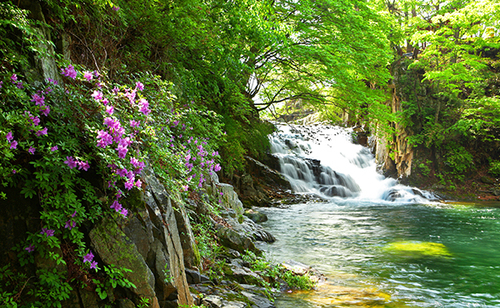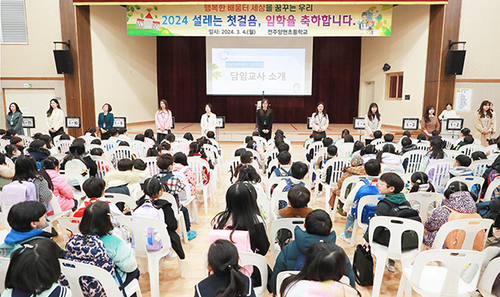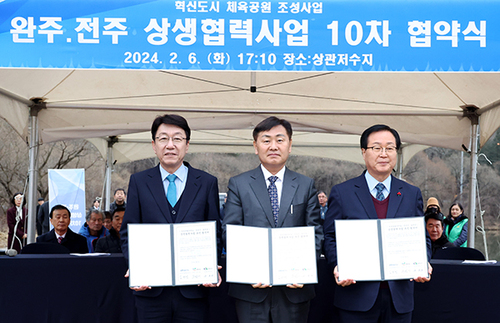| вЦ≤ м†ДлґБ к≥†м∞љкµ∞ мХДмВ∞л©і 'л≥Сл∞ФмЬД' мЭЉмЫРмЭі мЮРмЧ∞к≤љкіА л∞П мЧ≠мВђгЖНлђЄнЩФм†Б к∞АмєШл•Љ мЭЄм†Хл∞ЫмХД кµ≠к∞АмІАм†ХлђЄнЩФмЮђ л™ЕмКє(еРНеЛЭ)мЬЉл°Ь мІАм†Х мШИк≥†лРРлЛ§. / мВђмІДм†Ьк≥µ = к≥†м∞љкµ∞м≤≠ © кєАк∞АмШБ кЄ∞мЮР |
|
м†ДлґБ к≥†м∞љкµ∞ мХДмВ∞л©і 'л≥Сл∞ФмЬД' мЭЉмЫРмЭі мЮРмЧ∞к≤љкіА л∞П мЧ≠мВђгЖНлђЄнЩФм†Б к∞АмєШл•Љ мЭЄм†Хл∞ЫмХД кµ≠к∞АмІАм†ХлђЄнЩФмЮђ л™ЕмКє(еРНеЛЭ)мЬЉл°Ь мІАм†Х мШИк≥†лРРлЛ§.
л™ЕмКємЭА лЛ§л•Є лђЄнЩФмЮђмЧР лєДнХі мЪ∞л¶ђлВШлЭЉмЧРмДЬлПД 120кЄ∞ м†ХлПДлІМ мІАм†ХлР† м†ХлПДл°Ь нЭђмЖМмД±мЭШ к∞АмєШмЩА кіАкіСнЪ®к≥Љк∞А лІ§мЪ∞ нБ∞ кµ≠к∞АмІАм†ХлђЄнЩФмЮђлЛ§.
нКєнЮИ 'к≥†м∞љ л≥Сл∞ФмЬД'м≤ШлЯЉ мЮРмЧ∞мЬ†мВ∞мЭЄ л∞ФмЬДк∞А лђЄнЩФмЮђл°Ь мІАм†ХлРЬ мВђл°АлКФ 10мЧђ кЄ∞мЧР лґИк≥ЉнХШлЛ§.
к≥†м∞љкµ∞мЭА "лђЄнЩФмЮђмЬДмЫРнЪМк∞А 30мЭЉк∞Д мІАм†ХмШИк≥† л∞П к∞Бк≥Д мЭШк≤ђмЭД мИШл†інХШлКФ мЛђмЭШ м†Им∞®л•Љ к±∞м≥Р кµ≠к∞АмІАм†ХлђЄнЩФмЮђ л™ЕмКє(еРНеЛЭ)мЬЉл°Ь мµЬмҐЕ мІАм†ХнХі лђЄнЩФмЮђл≥інШЄл≤ХмЧР лФ∞лЭЉ м≤ік≥Дм†БмЭЄ л≥ім°ік≥Љ нЩЬмЪ©л∞©мХИмЭі лІИ놮лРЬлЛ§"к≥† 1мЭЉ л∞ЭнШФлЛ§.
'л≥Сл∞ФмЬД'лКФ л≥СмЭД к±∞кЊЄл°Ь мДЄмЫМ лЖУмЭА л™®мЦС к∞ЩкЄ∞лПД нХШк≥† л©Ал¶ђмДЬ л≥іл©і мВђлЮМ мЦЉкµі к∞ЩкЄ∞лПД нХЬ лђШнХЬ л™®мЦСмЭД нХШк≥† мЮИмЬЉл©∞ лЖТмЭі 35m м†ХлПДмЭШ нБђкЄ∞л°Ь мЬЧлґАлґДмЭі нБђк≥† мХДлЮШл°Ь л³놧мШђмИШл°Э мЮШл°ЭнХШлЛ§.
мІАмІИмХФмДЭ нТНнЩФмЮСмЪ©мЭШ лМАнСЬм†Б нКємІХмЭЄ 'нГАнПђлЛИ(tafoni = л∞ФмЬДм°∞к∞БмЭі лЦ®мЦім†Є лВШк∞Д нМ®мЭЄ нТНнЩФнШИгЖН饮еМЦз©і)'мЩА 'мЭЄм≤Ьк∞Х нХШкµђмКµмІА'мЩА мЧ∞к≤∞лРШлКФ м£ЉмІДм≤ЬмЭШ мГЭнГЬл•Љ кіАм∞∞нХ† мИШ мЮИлЛ§.
л∞ФмЬДлКФ мЖМл∞Шл∞ФмЬДгЖНлСРлЭљмХФ(м†ДмҐМл∞ФмЬД) лУ± м£Љл≥Ак≥ЉлПД мЮШ мЦімڪ놧 к≤љкіАм†Б к∞АмєШк∞А нБђк≥† л∞ФмЬД м£Љл≥А лСРмХФміИлЛємЧРмДЬ к∞ХнХЩмЧР кіА놮лРЬ лЛ§мЦСнХЬ лђЄнЧМк≥Љ нХ®кїШ мЛЬгЖНкЄАгЖНкЈЄл¶ЉмЬЉл°ЬлПД мШ§лЮЬ кЄ∞к∞Д к≥†м∞љнШДгЖНнЭ•лНХнШДгЖНлђімЮ•нШД лУ±мЧРмДЬ мІАмЧ≠мЭШ л™ЕмКємЬЉл°Ь мЧ≠мВђгЖНлђЄнЩФгЖНк≤љкіАм†Б к∞АмєШк∞А лЫ∞мЦілВЬ к≥≥мЭілЛ§.
мІАмІИнХЩм†БмЬЉл°Ь л≥Сл∞ФмЬД мЭЉмЫРмЭА 1мЦµ5,000лІМлЕД м†ДлґАнД∞ нШХмД±лРЬ кЄ∞мХФкіімДЭмЬЉл°Ь мє®мЛЭмЬЉл°Ь мГЭк≤®лВЬ мИШлІОмЭА лЛ®мХ†(cliff = мИШмІБмЬЉл°Ь кєНмХДмІАл•Є м†Ил≤љ)гЖНмК§нГЭ(stack = мЄµмЄµмЭі мМУмЭЄ нЗім†БмХФ)мЭі мЮИк≥† мЬ†лђЄмХФмІИ мЭСнЪМмХФмЭШ лЕЄлСРл•Љ кіАм∞∞нХ† мИШ мЮИмЬЉл©∞ нГАнПђлЛИ нХЩмКµмЮ•мЖМл°Ь м†БнХ©нХШлЛ§.
лШР, л≥Сл∞ФмЬДмЧР м∞©мГЭнХі мДЬмЛЭнХШлКФ лН©кµіл•Ш(л∞±нЩФлУ±гЖНлЛімЯБмЭі)мЭШ мЛЭмГЭнХЩм†Б к∞АмєШмЩА к≥Дм†ИмЧР лФ∞лЭЉ мГЙмЭД лЛђл¶ђнХШлКФ лУ±мЭШ к≤љкіАм†Б к∞АмєШк∞А нЫМл•≠нХі л™ЕмКєм†Б мІАм†Х м°∞к±імЭЄ к≤љкіА мГЭнГЬм†БгЖНлђЄнЩФм†БгЖНмЧ≠мВђм†Б мЭШлѓЄк∞А лєЉмЦілВШлЛ§.
л≥Сл∞ФмЬДлКФ 'мЧђмІАлПДмДЬ(нЭ•лНХ 1757)'мЩА 'нХілПЩмІАлПД(1750лЕДлМА міИ)гЖНнШЄлВ®мЭНмІАгЖНмІАл∞©мІАлПДгЖНк≥†м∞љнШДк≥Љ нЭ•лНХнШД(1872)' лУ± мЧђлЯђ кЄ∞л°ЭмЧР нШЄл¶ђл≥С л∞ФмЬДлЭЉлКФ лЬїмЭШ 'нШЄмХФ(е£ЇеЈЦ)'мЬЉл°Ь нСЬкЄ∞лРРк≥† л≥С л™®мЦСмЬЉл°Ь ꣪놧솪 мЮИлКФ лђЄнЧМмЮРл£М лУ±лПД нЩХмЭЄлПЉ мЧ≠мВђмД±лПД к∞ЦмЈДлЛ§.
кіА놮лРЬ м†ДмД§мЭА 'мД†лПЩлІИмЭД лТ§ мД†мЭЄліЙ л∞ШмХФ лТ§ мЮФмєЂмІСмЧРмДЬ л™ємЛЬ мЈ®нХЬ мЛ†мД†мЭі мУ∞лЯђмІАл©імДЬ мЖМл∞Ш(е∞ПзЫ§ = мЮСмЭА л∞•мГБ)мЭД к±ЈмЦім∞®мЮР мЖМл∞Ш мЬД мИ†л≥СмЭі кµілЯђ лЦ®мЦім†Є мЭЄм≤Ьк∞Хк∞АмЧР к±∞кЊЄл°Ь кљВнЮМ к≤ГмЭі л≥Сл∞ФмЬДк∞А лРШмЧИлЛ§'лКФ мЭімХЉкЄ∞к∞А м†ДнХім†Є л³놧мШ§к≥† мЮИлЛ§.
мЬ†кЄ∞мГБ к≥†м∞љкµ∞мИШлКФ "к≥†м∞љк∞ѓл≤МмЭШ мЬ†лД§мК§мљФ мДЄк≥ДмЮРмЧ∞мЬ†мВ∞ лУ±мЮђмЩА нХ®кїШ лШР нХШлВШмЭШ кµ≠к∞АмІАм†Х л™ЕмКє мІАм†ХмЬЉл°Ь 'м≤≠м†Хк≥†м∞љ'л∞П 'мГЭнГЬ мєШмЬ†мЭШ мЧ≠мВђгЖНлђЄнЩФгЖНкіАкіСлПДмЛЬ'мЭілѓЄмІАл•Љ лНФмЪ± лґАк∞БмЛЬнВђ мИШ мЮИк≤М лРРлЛ§"к≥† л∞ЭнШФлЛ§.
кЈЄлЯђл©імДЬ "кЄ∞м°імЭШ кіАкіС л∞П лђЄнЩФм†Хм±Ек≥Љ мЧ∞к≥ДнХі мЛЬлДИмІА нЪ®к≥Љл•Љ л∞ЬнЬШнХ† мИШ мЮИлПДл°Э нЦЙм†Х놕мЭД л™®мЬЉк≤†лЛ§"к≥† лНІлґЩмШАлЛ§.
вШЮ мХДлЮШлКФ мЬД кЄ∞мВђл•Љ кµђкЄА л≤ИмЧ≠мЭі л≤ИмЧ≠нХЬ мШБлђЄмЭШ 'м†ДлђЄ'мЭілЛ§.
гАРBelow is the 'full text' of an English article translated from the above article with Google Translate.гАС
Gochang Byeongbawi Rock designated as 'National Cultural Heritage Site of Scenic Beauty'
Cultural Heritage AdministrationвА¶ High evaluation of beautiful scenery, historical and cultural values
Reporter Kim Ga-young
The area of 'Byeongbawi' in Asan-myeon, Gochang-gun, Jeollabuk-do has been recognized for its natural scenery and historical and cultural value, and has been designated as a nationally designated cultural heritage site of scenic beauty.
Scenic Spots are nationally designated cultural properties with a high value of rarity and tourism effect, to the extent that only about 120 sites are designated in Korea compared to other cultural properties.
In particular, there are only about 10 cases of natural heritage rocks designated as cultural assets, such as 'Gochang Byeongbawi Rock'.
Gochang-gun announced on the 1st that "The Cultural Heritage Committee will finally designate it as a nationally-designated cultural heritage site after a 30-day notice of designation and a deliberation process that collects opinions from various fields, and a systematic preservation and utilization plan will be prepared in accordance with the Cultural Heritage Protection Act."
'Byungbawi' looks like an upside-down bottle, and when viewed from a distance, it has a strange shape that resembles a human face.
You can observe 'tafoni', which is a typical characteristic of geological rock weathering, and the ecology of Jujincheon, which is connected to 'Incheon River Estuary Wetland'.
The rocks have great scenic value as they blend well with the surrounding areas such as Sobanbawi Rock and Durakam Rock (Jeonjwabawi Rock). It is a place of outstanding historical, cultural, and scenic value as a local scenic spot.
Geologically, the area of Byeongbawi Rock is a strange rock formation formed 150 million years ago, and there are numerous cliffs (cliff = vertical cliffs) and stacks (stack = sedimentary rocks stacked in layers) formed by erosion, and outcrops of rhyolite tuff can be observed. It is also suitable as a place for tarpony learning.
In addition, the ecological, cultural, and historical significance of the landscape, which is a condition for designation as a scenic spot, is outstanding due to the vegetative value of vines (flowers and ivy) that are epiphytic and inhabiting the rocks and the landscape value, such as changing colors according to the seasons.
Byeongbawi is named вАШHoam (е£ЇеЈЦ)вАЩ, meaning Goribyeong Rock, in various records such as вАШYeojidoseo (Heungdeok 1757)вАЩ and вАШHaedongjido (early 1750s), Honam-eupji, local maps, Gochang-hyeon and Heungdeok-hyeon (1872)вАЩ. ' and documented material drawn in the shape of a bottle have also been confirmed, giving it a sense of history.
A related legend is that, "At the feast house behind Seoninbong porphyry behind Seondong Village, a very drunk god fell and kicked a soban (е∞ПзЫ§ = small table). it's coming down
On the other hand, Gochang-gun Mayor Yu-sang Yu-sang said, "With the registration of Gochang Tidal Flat as a UNESCO World Natural Heritage Site, it is possible to further emphasize the image of 'Clean Gochang' and 'City of history, culture and tourism of ecological healing' by designating another nationally designated scenic spot." said.
He added, "We will gather administrative power so that we can create synergy effects in connection with existing tourism and cultural policies."




 мї§лЃ§лЛИнЛ∞
мї§лЃ§лЛИнЛ∞  нФЉнФМ
нФЉнФМ  лПЕмЮРнИђк≥†
лПЕмЮРнИђк≥†
















 лІОмЭі л≥Є лЙімК§
лІОмЭі л≥Є лЙімК§











